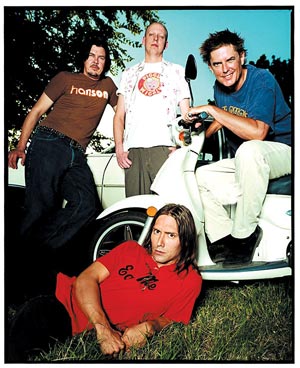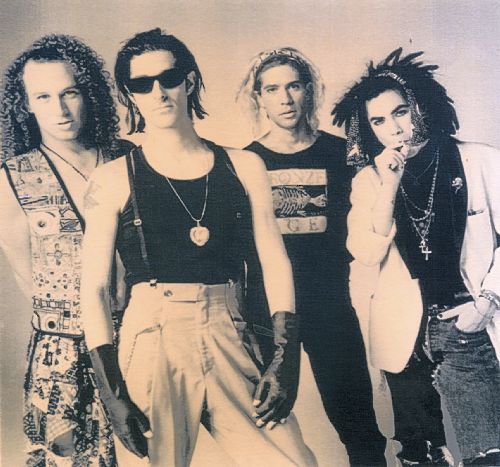Who Are They?
One huge, chaotic, darkly comic drug trip of a band. (Side
note: this entry is going to be filled with ridiculous fun facts because this
band is just too weird, but in a good way.)
Like Bad Religion, Butthole Surfers got their start in the
late ‘70s/early ‘80s in the hardcore punk scene. (Yes, believe it or not, there
was a hardcore punk scene in San Antonio, Texas.)
Oddballs Gibby Haynes and Paul Leary met in the ‘70s at
Trinity University in San Antonio and bonded over their shared taste in
non-mainstream music. Gibby landed a job at an accounting firm, while Paul
stayed in college to work on his degree.
(Fun fact: Gibby and Paul published a magazine in 1981
called Strange V.D., which was
basically a collection of abnormal medical disorder photos, complete with
hilariously fictitious explanations for each one.)
After playing a few shows in San Antonio with the sibling
rhythm section of Quinn and Scott Mathews, the band (not known as Butthole
Surfers at this point) bought a van and headed to California. During a concert
in San Francisco, Dead Kennedys frontman Jello Biafra became a fan of the band
and invited them to open for his band.
(Fun fact: The band didn’t settle on the name Butthole
Surfers until its first paid gig. Prior to that, they performed under various
aliases, including the Vodka Family Winstons, Ashtray Babyheads, Ed Asner Is
Gay and The Inalienable Right To Eat Fred Astaire’s Asshole.)
Jello soon offered them a chance to record an EP and release
it through his record label, Alternative Tentacles. The Mathews brothers
ditched the band following an altercation between Scott and Gibby, so bassist
Bill Jolly and drummer King Coffey filled in.
The resulting EP, 1983’s Butthole
Surfers (also known as Brown Reason
to Live and Pee Pee the Sailor),
was just a preview of the band’s albums to come.
(Fun fact: Butthole Surfers’ first EP became one of Kurt
Cobain’s favorite albums. He actually met Courtney Love at a Butthole
Surfers/L7 concert in 1991.)
After several dozen lineup changes (I’m not even going to
bother listing all of them because there are just too many) and two fantastically strange albums (1984’s Psychic…Powerless…Another Man’s Sac and 1986’s
Rembrandt Pussyhorse) the legend of
Butthole Surfers began to grow. Their chaotic live shows attracted a plethora
of weirdos and punk rockers alike, featuring everything from strobe lights and
smoke machines to naked dancers and cross-dressing.
(Fun fact: At the end of the band’s first tour, the boys
settled in a small town in Georgia, where they admitted to stalking members of
R.E.M. They would leave a van parked in front of Michael Stipe’s house that had
the message “Michael Stipe/Despite the Hype/I’d Love to Suck/Your Big Long
Pipe” painted on the side.)
The Surfers returned to Texas in 1986 to record a follow-up
to Rembrandt Pussyhorse, which
resulted in their heaviest record to date, 1987’s Locust Abortion Technician. (This album is sometimes considered to
be an early precursor of grunge, which makes sense since Kurt Cobain was such a
huge Butthole Surfers fan.)
Hairway to Steven,
released in 1988, was a delicate mix of the band’s experimental roots and the
more accessible sound that would later give the Surfers mainstream success.
After the release of piouhgd in 1991,
Butthole Surfers shocked the world and signed to Capitol Records. They teamed
up with bass legend John Paul Jones (of Led Zeppelin, if you have to ask) and
released the much more mainstream Independent
Worm Saloon in 1993.
The album gave them their first rock radio hit, “Who Was In
My Room Last Night?” (complete with a bizarrely awesome music video).
After losing yet another band member, Gibby and Paul pursued
side projects. Gibby’s side project, P, featured the musical talents of Johnny
Depp, Bill Carter, Sal Jenco and Flea.
(Fun fact: P was the band playing at the Viper Room in Los
Angeles the night River Phoenix died of a drug overdose.)
In 1996, the Surfers released their most successful album, Electriclarryland. The lead single,
“Pepper,” became a Top 40 hit and propelled the album to number 31 on the
Billboard 200 chart.
Despite the surge of popularity (and money), Butthole
Surfers didn’t get along with their record label. The planned 1998 project After the Astronaut was scrapped and the
band ditched its manager.
Where Are They Now?
Touring sporadically, but not in support of any new
material.
The Surfers resolved their little tiff with Capitol Records
and released Weird Revolution in
2001. The album included rerecorded After
the Astronaut outtakes and another successful single, “The Shame of Life.”
Since the release of Weird
Revolution, Butthole Surfers have toured intermittently, even making an
appearance at the 2008 All Tomorrow’s Parties festival.
(Fun fact: All Tomorrow’s Parties founder and organizer
Barry Hogan reportedly told The Village Voice that after watching Butthole
Surfers’ performance, they would never play the festival again.)
The band’s last tour was in 2011 and only included 12 stops.
Is this the end of Butthole Surfers?
But Why Butthole
Surfers?
While it’s true that these guys haven’t done much in the
last couple of years, there’s still a possibility that new material may turn
up. Paul and King Coffey recently stated that the Surfers will tour again if
they can pull off another album.
What Does Sam Think?
I always pair Butthole Surfers with Primus, and I think
that’s because they’re both really strange bands. But if we’re really having a
strange contest here, the Surfers out-weird Primus every time.
First of all, if the only Butthole Surfers song you know is
“Pepper,” you’re in for a treat if you choose to listen to the rest of their
discography. And by “treat,” I mean a bad acid trip.
If you’re not a fan of psychedelic, glitchy sound splices,
steer clear of the band’s first few albums. Locust
Abortion Technician makes a little more sense (and sounds a bit closer to
metal than anything), but a first-time listener should always start with Electriclarryland.
So what makes this band so weird (and why is that a good
thing)? Well, the Surfers incorporate a lot of different elements into their
music. They experiment with psychedelia, noise rock, punk rock and a touch of
electronica, as well as a healthy dose of sound manipulation and tape editing.
There are noises on their albums that you will never hear anywhere else.
This is some really underground stuff, guys. I understand
that it’s not everyone’s cup of tea, but you have to respect the experimentation.
There really aren’t any other bands that sound like Butthole Surfers at the
moment. I mean, some of their songs sound like pure chaos, but others sound
like fairly accessible (though slightly off-kilter) alternative tracks.
It honestly surprises me that this band reached the
mainstream. “Pepper” may be a pretty tame track by Surfers standards, but it’s
still a little weird to hear on the radio. With lyrics like “Flipper died a
natural death, he caught a nasty virus / And then there was the ever-present
football player rapist,” how did this song become so popular? But I guess that
was after Nirvana had paved the way for alternative bands to get a little
weirder on the radio.
But if you do dig all the crazy shit this band puts out, hit
me up and we’ll get weird, Locust
Abortion Technician style.
-- Sam Boyer,
reporting from the ‘90s.







